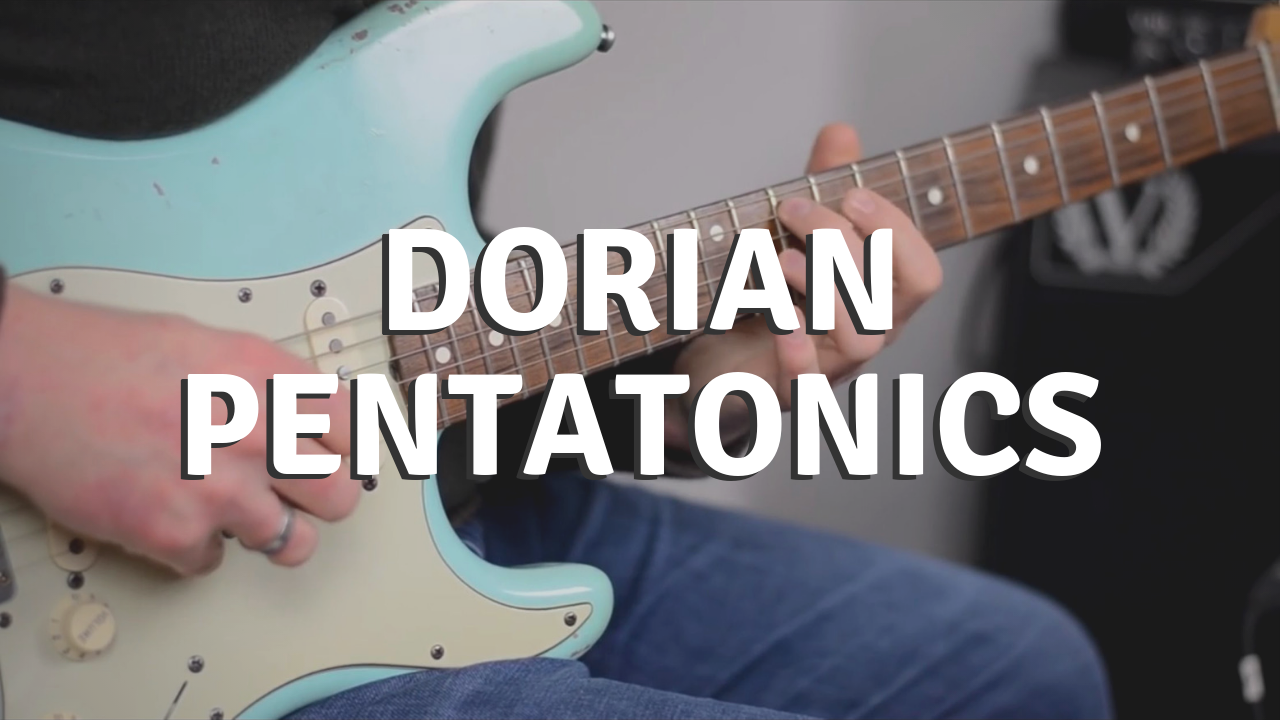Help! Modes!
I think it’s safe to say that most guitar players feel right at home using the good old trusty Pentatonic Minor scale, but, when first expanding their musical palette with the Diatonic Modes, that musical freedom, phrasing and familiar licks etc. seem to evade them.
This may be as a result of using a three-note-per string or CAGED approach and thinking of these new scales as completely new ‘forms’ to learn. If we simplify the approach to learning a new scale by altering something we are already familiar with not only does this aid the learning process but we can also hear what’s going on with our new sound by comparison.
A great way to start getting into the playing and hearing of new modal sounds is to take the familiar Pentatonic scale and slightly alter it in a particular way that targets the specific contextual sound of a particular mode.
Dorian, what is it?
In this lesson we’re going to be doing this with the sound of the Dorian mode. The Dorian sound is very common in Jazz, Funk and Fusion styles but also can be heard in all manner of Rock and Pop songs etc.
If we look at the theory of what’s going on here, the Dorian scale is made up by taking a starting note and moving along the following sequence of whole tones and semi-tones T S T T T S T, so for example if we were playing A Dorian we would have the notes A B C D E F# G.
For the purposes of this lesson, a much more versatile and informative way to think about this would be in terms of musical intervals. For Dorian we have 1 2 b3 4 5 6 b7.
Comparing this to other diatonic modes the signature interval that really stands out here is the major 6th interval in a minor context (b3, b7), adding a certain brightness to the otherwise dark minor flavour.
Dorian Pentatonic
So how are we going to use this information with our friendly Pentatonic Minor? Let’s first look at the intervals of our Pentatonic minor scale. Ascending up the scale we have the following intervals 1 b3 4 5 b7. As we have already seen, our full Dorian follows 1 2 b3 4 5 6 b7, so we can see that Dorian is the same as Pentatonic Minor but with an added 2 and 6 interval!
There are a few ways we could create a five note, pentatonic, scale from this 7 note Dorian, but for us to get our Dorian flavour in a Pentatonic form, we can see that we really want that major 6th so let’s take our Pentatonic Minor and change the b7 interval to a 6.
| Pentatonic Minor | 1 | b3 | 4 | 5 | b7 | |||||||
| Dorian Mode | 1 | 2 | b3 | 4 | 5 | 6 | b7 | |||||
| Dorian Pentatonic | 1 | b3 | 4 | 5 | 6 |
Let’s look at how this appears on the fingerboard. Starting with a very familar pattern for playing the Pentatonic Minor scale:

Pentatonic Minor ‘E’ Form
If we then move or replace the b7th interval with a major 6th we get:

Dorian Pentatonic ‘E’ Form b7 Interval moved back/replaced with major 6th
So for a very slight tweak of the familiar Pentatonic Minor we can delve into the Dorian sound!
Let’s play it!
Let’s now play around with this new pentatonic and its implications for existing licks you may know, here is a typical A Pentatonic Minor lick
 Lick 1 – A Pentatonic Minor
Lick 1 – A Pentatonic Minor
If we then exchange our b7 intervals for a 6 (highlighted) we get:

Lick 2 – A Dorian Pentatonic b7 interval moved back to major 6th
You can instantly hear the difference that change makes. Let’s take another idea:

Lick 3
and again moving our b7th to a major 6th:

Lick 4
A great Dorian sounding idea simply by tweaking the Pentatonic Minor. This concept is very handy as it potentially allows us to take our existing pentatonic licks, with all their comfortable phrasing etc. and quickly change them to get a more Dorian flavour.
Some more licks
Let’s look at a few more lick ideas.
Here we have a string skipped phrase that uses a Dorian Pentatonic at the 12th position or ‘A’ form if you are familiar with the CAGED system.

Lick 5
This lick is based around a Dorian Pentatonic around the 10th position or ‘C’ form and illustrates how certain forms may feel a little nicer, positionally, under the fingers.

Lick 6
The last lick here shows how you can also take your existing 3nps pentatonic forms and alter them for the Dorian Pentatonic paving the way for more fluid sounding lines.

Lick 7
Try it out
Hopefully this relatively simple concept helps you to get a much better hold over using the Dorian sound in your playing.
I highly recommend you taking all your known forms for Pentatonic Minor (writing them out if that helps – I’ve got some blank scale diagrams here), finding that b7 (it’s a whole tone behind the root note) and changing it to a major 6th (move it back just one fret) then just have fun playing about with your existing licks.
Finally, here is the backing track for you to try out those ideas covered:







0 responses on "LESSON: Dorian Pentatonics"